Abstract
Background: Transtibial prosthetic sockets are critical components in the complete assembly of a prosthetic, as they form the major load-bearing parts by housing the residual limb of a prosthesis user. Conventional procedures for manufacturing these sockets require repeated iterations and manual casting, baking, and drying, which often lead to longer processing and waiting times. Additive Manufacturing (AM) enables the creation of bespoke designs with meticulous control over the socket’s shape, thickness, and material composition. Method: To design and propose an optimal socket design to a lower-limb prosthetic user based on their preference of activity such as walking, running, and jumping, we investigated seven materials—Polypropylene (PP) standard material for conventional socket fabrication, Polylactic-acid-plus (PLA+), Polyamide (PA) Natural, Polyamide-6-Glass-Fiber (PA6-GF), Polyamide-copolymer (CoPA), Polyamide-6-Carbon-Fiber (PA6-CF), and Polyamide-12-Carbon-Fiber (PA12-CF)—that have AM compatibility by subjecting them to heavy external loading and evaluating their von Mises stress–strain behavior. Result: Using Finite Element Analysis (FEA), we evaluated a single-material design and a combination design with two materials—one major (low cost) and one minor (higher cost)—to optimize a composition that would bear heavy external loads without yielding. A maximum load-bearing capacity of 3650 N was achieved with the combination of PLA+ and 31.54 vol% PA6-CF (30.23 weight%, 99.13 g), costing about USD 14 for the total socket material. Similarly, a combination of PLA+ with 31.54 vol% PA6-GF (30.76 weight%, 101.67 g) exhibited a maximum load-bearing capacity of 2528.91 N. Conclusions: The presence of high-strength CF and GF in minor compositions and at critical locations within the transtibial socket are the suggested reasons for these enhanced load-bearing capacities, due to which these sockets could be used for undertaking a wider range of activities by the prosthesis users.
1. Introduction
The incidence of lower-limb amputation is a large and growing healthcare issue in the developed and developing world. Such amputees often face societal hurdles in terms of discrimination, limited opportunities, social stigma, financial burden, and dependence on other members for their daily routines [1]. The provision of a prosthetic limb that is functional and comfortable helps to alleviate some of these issues. With the advancement in prosthetic technology, several modern artificial devices have been invented, which assist such patients to lead a normal life. The Global Artificial Lower-Limb Prosthetic market size at present is USD 1.1 billion and is estimated to expand at 4.70% from 2024 to 2030, which would be further augmented due to the prevalence of comorbidities such as diabetes among an aging population [2]. A further segmentation of the lower-limb prosthetic market could be artificial prosthetic knee, leg, foot, and ankle [3]. Among these, both transfemoral and transtibial prosthetics are the most commonly demanded products, and their success is largely dependent upon the quality of the socket component used as a part of its complete assembly.
To replace the limb, a fully functional prosthesis is necessary, capable of mimicking the motion of the limb and supporting the body during routine activities. A precisely designed socket is essential for achieving this functionality. A socket acts as a coupling device, connecting the residual limb to the prosthetic limb [4]. A robust and comfortable socket is indispensable for the proper use of the prosthetic limb, as it is responsible for efficiently transferring forces from the residual limb to the prosthesis during a gait motion. Patients expect a prosthesis that fits snugly, offering the highest levels of comfort and functionality. Additionally, the prosthesis should be esthetically pleasing and lightweight [5].
The utilization of transtibial prosthetics is crucial for individuals who have undergone lower-limb amputations, as these prostheses facilitate mobility and enhance a prosthesis user’s overall quality of life. The design and selection of materials for these prostheses are paramount in determining their performance, comfort, and durability [6].
Prosthetic sockets are fabricated using various technologies, including wood-based sockets, laminated sockets, and 3D-printed sockets [7,8,9]. As technology continues to advance, the demand for robust, functional, and lightweight sockets is on the rise. Conventional prosthetic production techniques, such as plaster casts, hand craftsmanship, and numerous fitting sessions, can lead to less-than-ideal fits and are frequently expensive and time consuming [10]. Conversely, 3D printing provides several benefits, including lower costs, greater personalization, and better patient outcomes. Traditional methods of manufacturing sockets often fail to achieve the precise fitment required, resulting in loose fitting that allows for relative motion between the socket and the residual limb, leading to discomfort [11,12]. The Polypropylene (PP) material utilized in the fabrication of sockets needs to be substituted with alternative composite materials to enhance the mechanical properties of the socket, thereby extending its lifespan and increasing comfort for a prosthesis user. PP as a polymer material is subject to variations in mechanical properties with varying atmospheric temperatures and moist conditions, which is undesirable.
Historically, the fabrication of prosthetic sockets relied on manual techniques like casting and molding. While effective, these methods often lacked precision and scalability. These limitations have spurred a transition towards digital and automated solutions, thereby enhancing the accessibility and adaptability of prostheses [13].
Lower-limb prosthetic sockets, and particularly those designed for transtibial prosthesis users, are subjected to substantial mechanical loads during activities such as walking or climbing stairs. The distal region of these sockets often encounters elevated stress levels, resulting in material fatigue and eventual failure. Traditional materials like PP have been widely used in the prosthetics industry but may not adequately meet the requirements of contemporary and active individuals [14]. The incorporation of advanced materials such as carbon fiber-reinforced polyamides Polyamide-12-Carbon-Fiber (PA12-CF) and Polyamide-6-Carbon-Fiber (PA6-CF) and glass-filled composite Polyamide-6-Glass-Fiber (PA6-GF), in conjunction with flexible materials like Polylactic-acid-plus (PLA+), presents a potential solution to these challenges [15].
AM techniques such as Fused Deposition Modeling (FDM) enable the precise placement of materials, facilitating strategic design enhancements. Through the combination of high-strength materials in the distal region and cost-effective, flexible materials in the proximal region, prosthetic sockets can achieve an optimal balance of strength, comfort, and affordability [15]. Recent research emphasizes the benefits of using FEA to evaluate the mechanical performance of prosthetic sockets [16]. For instance, simulation studies have demonstrated how PLA+ sockets, though cost-effective, show higher deformation under dynamic loads compared to advanced composites like PA12-CF. These findings stress the importance of material selection to ensure both stability and comfort [15]. Other studies showcased the integration of lattice structures in socket designs, which improves flexibility and reduces material usage while maintaining strength [9,17].
Material selection plays a critical role in the success and performance of load-bearing prostheses fabricated using AM technology. Researchers have explored a wide range of material combinations, including PLA+, carbon, carbon–Kevlar, fiberglass fiber reinforcements, and cement-sprayed sockets [18,19,20]. PLA+ is also commonly employed in the manufacturing of sockets. To determine whether the sockets can reliably support the loads imposed by the user’s weight and movement, they were subjected to ultimate strength testing in accordance with BS EN ISO 10328–2006 test guidelines [21]. Two distinct stances of the human gait cycle were examined to ensure functionality: heel strike, which is more susceptible to stresses, and toe off. During regular walking, the socket endures repeated stress from the ground, with the highest forces exerted by the ground reaching up to 110–120% of the individual’s body weight [21]. Actions such as jumping, turning, and changing pace can induce even higher and more rapid stress levels [22]. To prevent the socket from failing, the maximum force (failure force) of the prosthetic socket must be sufficiently robust to manage the cumulative effects of these stresses encountered during daily activities.
With these aspects of the design and fabrication of transtibial sockets, it has been observed that there is still limited disruption caused by digital technologies in this domain. Several parts of the world are still dependent upon the conventional technologies of plaster casting, molding, and sheet draping for the design and fabrication of transtibial sockets, which leads to excessive time consumption, longer waiting times for patients, and lower accuracy.
Therefore, in this paper, we attempt to investigate the mechanical properties of 3D printable materials that could be sustainable for fabricating these sockets such that these sockets could bear heavier external loads that a prosthesis user would bear during different sets of activities such as standing, walking, running, and so on, using FEA. Materials such as PLA+, Polyamide (PA) Natural, PA6-GF [23], Polyamide-copolymer (CoPA), PA6-CF, and PA12-CF have been investigated as single materials and as a two-material combination for designing a hybrid socket that would be able to sustain heavy external loading without failures. As the range of materials available for 3D printing continues to expand, it becomes increasingly crucial to assess their suitability for load-bearing applications in prosthetic devices.
2. Materials and Methods
2.1. Transtibial Socket Design
A 3D model of a residuum of a transtibial prosthesis user model was obtained from GitHub [24] as an open-source repository to design a transtibial prosthetic socket for analyzing the load distribution across various sections of the socket, to ascertain its reliability in real-life situations. Autodesk Meshmixer 3.5.0, an open-source Computer-Aided Design (CAD) modeling software, was used to design this socket with an overall thickness of 4 mm [25] to the socket as shown in Figure 1. The markings on the residual limb that forms the basis of a socket design have been recommended by a certified and experienced Clinical Prosthetist and Orthotist (CPO) who also provided positive feedback for the socket design. The socket model comprised a volume of 300 cm3, an overall height of 296 mm, and a total weight of 330 g for PLA+ and 300 g for PP. ANSYS 2022 R2 was used for applying an external load of 1300 N on this socket design [26] for various materials such as PLA+, PA Natural, PA6-GF, CoPA, PA6-CF, and PA12-CF.
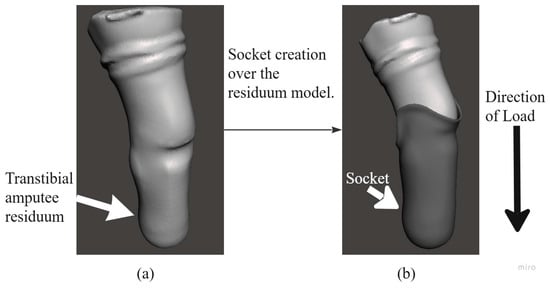
Figure 1.
(a) 3D model of the residuum of a transtibial prosthetic user. (b) Socket designed over the residuum.
2.2. Materials for Socket Design and Manufacturing
PP has been widely used for socket design and conventional manufacturing due to its desirable properties such as low density, relatively high thermal stability, easy processing, resistance to corrosion, and ease of availability [27,28]. Three-dimensional printable polymer materials that possess similar characteristics to PP could also be suitable for lower-limb socket design. Therefore, materials such as PP, PLA+, PA Natural, PA6-GF, CoPA, PA6-CF, and PA12-CF that were available in filament form, suitable for FDM 3D printing, were used in this study. Table 1 shows the filament properties of these materials along with the PP sheet which is used in conventional socket manufacturing.

Table 1.
Material properties used for socket design and manufacturing.
2.3. Two-Material Hybrid for Socket Design
Table 1 indicates the weaker mechanical properties of various materials proposed for use in lower-limb socket design; however, under conditions when the socket is exposed to strenuous activities, it would experience heavier loads and therefore would be vulnerable to failure. Materials comprising CF and GF possess stronger mechanical properties; however, their cost of manufacturing for such a large volume size of socket would be very high; hence, this would be an unviable option.
Under such conditions, the socket design would require alteration, and a combination of two materials would be required. The material combination approach would be focused on cost-effectiveness, mechanical strength, and the suitability of joining mechanisms such as hot tool welding, hot gas welding, hot plate welding, etc. [36].
For the design process, in the hybrid formed by the combination of the two materials, the socket was segmented into two distinct regions, as distal (minor) and proximal (major), as shown in Figure 2a. The STL model was converted into a solid model before segmentation. The distal (minor) region comprised the mechanically stronger material (PA6-CF filament, PA12-CF filament, and PA6-GF filament), while the proximal (major) material comprised the PLA+ and PP materials.
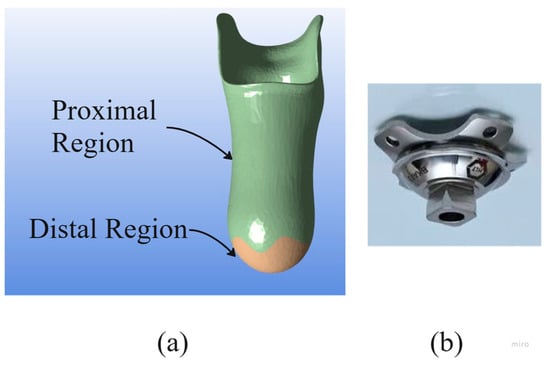
Figure 2.
(a) Distal (minor) and proximal (major) segmentations of prosthetic socket model. (b) Adapter used as reference for splitting tool.
Segmentation was executed by orienting the socket model upright, maintaining the open portion at the top. To ensure a smooth transition between the major and minor materials and reduce stress concentration at the interface, a wave-shaped splitting tool was suggested. Once the model was correctly oriented with the base of socket (distal end) contacting the ground plane, a wave was generated at a height of 2 cm from the base to function as a splitting tool.
Subsequent segmentations were designed by incrementing the height in steps of 5 cm each, equivalent to the volume percentage of the minor material composition in the complete socket volume. The volume percentage varied between 15 vol% and 50 vol% and incremental steps for the height were set accordingly. The overall weight of the minor compositions corresponding to this volume percentage varied between 50 g and 160 g, as per their densities. The undulating pattern of the splitting tool aligns with the curved design pattern of the adapter that would be attached at the distal end, as shown in Figure 2b. Figure 3 shows the variation in the volume distribution of the minor compositions across the socket.
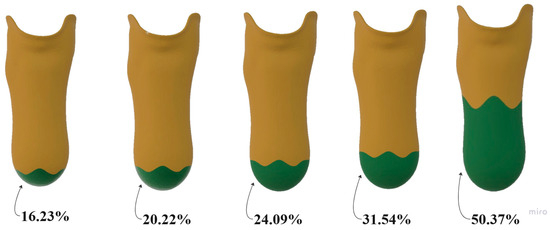
Figure 3.
Volume distribution of the minor compositions indicated in green color across the socket.
Based on this, a two-material hybrid socket was designed and subjected to FEA studies to evaluate their maximum load-bearing capacities.
3. Results
3.1. Finite Element Method (FEM)
A 3D model of the socket was designed for both single-material and two-material properties, as shown in Table 1. A mesh convergence [37] investigation was carried out as an integral component of the model validation process. The objective was to identify the optimal mesh size that would strike a balance between computational efficiency and solution precision. This study was conducted in a systematic manner, involving a sequence of simulations performed with varying mesh densities.
The optimal mesh size was determined as 0.75 mm via mesh convergence study. Our analysis focused on key response parameters such as maximum stress and total deformation. We observed that refining the mesh to 0.75 mm led to significant improvements in result accuracy. However, further refinement from 0.75 mm to 0.5 mm resulted in differences of less than 1% in these parameters, while also substantially increasing the computational cost. Based on these findings, a mesh size of 0.75 mm was selected as the optimal balance between accuracy and efficiency and was subsequently employed for all simulations involving the geometry under consideration.
3.2. Boundary Conditions
In practice, the distal extremity of a socket is connected to a pylon, which is a hollow, cylindrical metal rod through an adapter. The pylon, at its other end, is linked to a prosthetic foot. Meanwhile, at the proximal end, the prosthesis user places his/her residual limb. During the acts of standing or ambulation, the patient exerts a load upon the socket, which is transmitted to the ground via the socket’s distal end, adapter, pylon, and foot. During this load transfer process, significant joint action is absent at the distal end, which would bear the major load of a patient’s weight during movement. Therefore, the end which connects the distal region with an adapter has been considered as a fixed end during simulation [11].
The simulation modeled a transtibial socket under a static load of 1300 N as per ISO 10328 for a healthy person with a safety factor of 1.5 [16], representing the forces exerted by an individual while ambulating [21]. The socket was affixed at the base, representing the adapter’s position as shown in Figure 4a. The effective area for loading was contained within the socket’s surfaces, which would come into contact with the amputated residuum as shown in Figure 4b. The load’s direction was vertically downward, representing the body weight in the direction of acceleration due to gravity.
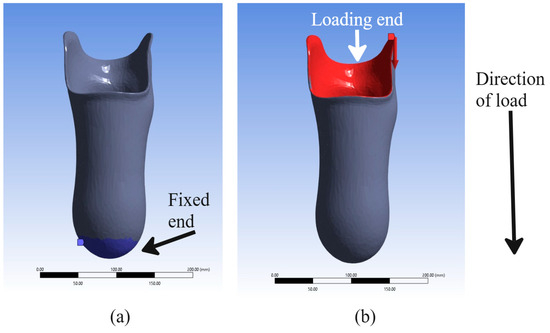
Figure 4.
Boundary conditions for the ANSYS study: (a) fixed end at distal region. (b) Loading end at proximal region.
3.3. FEA
The 3D model for testing is exported as igs file format for load analysis in ANSYS 2022 R2. The socket design was converted into a mesh, as shown in Figure 5, for the further processing of FEA simulation under various loading conditions and materials with a mesh size of 0.75 mm with 1,549,288 nodes and 906,842 tetrahedron-shaped elements. For the static structural analyses presented, we used Workbench’s default solution approach. Specifically, we used a direct sparse solver (often implemented as the MUMPS solver in ANSYS) to efficiently and accurately solve the system of equations for our predominantly linear static problem. This solver is well suited to handle large-scale problems with complex boundary conditions and ensures robust convergence [38,39,40]. Figure 6 shows the results of the equivalent von Mises stresses and deformations when a representative socket is subjected to external loading of 1300 N.
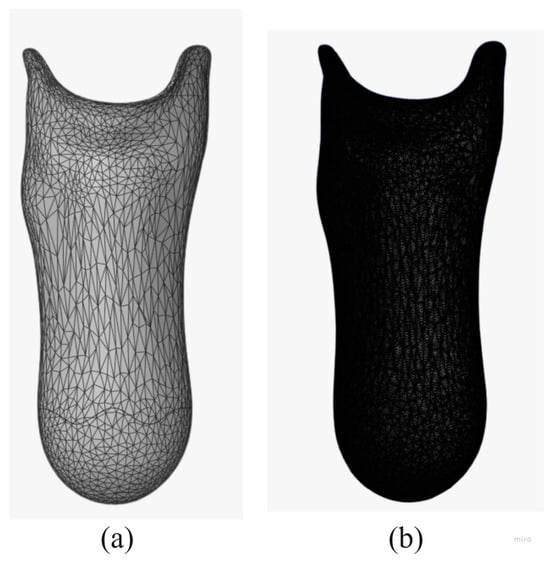
Figure 5.
Mesh distribution for the socket model with (a) coarse mesh size and (b) optimized mesh size.
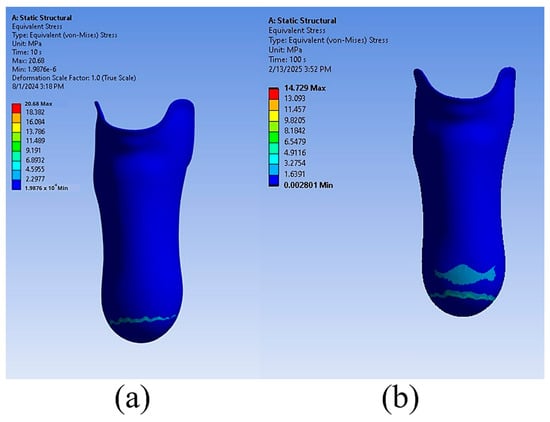
Figure 6.
FEA on socket for (a) equivalent von Mises stresses on single material; (b) equivalent von Mises stress on two-material combination.
During the FEA process, the two materials are assumed to have a bonded contact [41]. Subsequently, they are fabricated using a two-nozzle 3D printer capable of printing with distinct materials. The distribution or composition of the distal and proximal region were optimized for maximizing the load-bearing capacity.
3.3.1. Single-Material Analysis
Commonly used polymer materials that are lower in cost and easily available such as PP and PLA+ were simulated using FEA. Table 2 shows the results obtained for maximum von Mises stresses and strains when these materials were subjected to a compressive load of 1300 N.

Table 2.
Von Mises stress and strain results exhibited by various socket materials when subjected to the external load of 1300 N.
Based on the load and von Mises stress characteristics obtained in Table 2, safety factor values for these materials are shown in Figure 7.
Safety Factor = Tensile strength/Maximum von Mises Stress
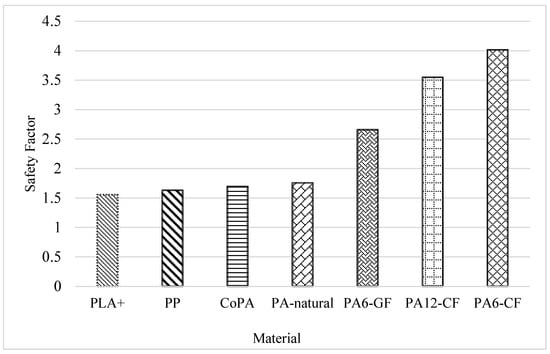
Figure 7.
Safety factors for various materials when subjected to an external load of 1300 N.
As per the values shown in Figure 7, a standard value of safety factor of 1.5 was fixed for evaluating the maximum load-bearing capacity while each of these materials used to design the sockets were single or in combination. As observed from Figure 7, PA6-CF, PA12-CF, and PA6-GF had significantly higher values of safety factors, thereby strengthening their usage under extreme loading conditions.
However, their availability, manufacturing, and cost remain persistent challenges, due to which we have explored a hybrid material socket that comprises a minimal composition of these high-strength materials combined with major compositions of PP and PLA+. The maximum load-bearing capacity for PP was found to be 700 N, while for PLA+ it was 1320 N, making them extremely vulnerable to failure for any real-life situations.
The material cost involved in THE 3D printing of a single unit socket ranged between USD 10 for PLA+ and USD 55 for PA12-CF. Therefore, considering other overheads and skilled manpower costs would add up to an expensive transtibial socket solution, it becomes imperative to optimize the material cost to keep the socket cost affordable. Hence, the CF- and GF-based polymer material composition was proposed to remain minimal and to have control over the overall socket cost.
3.3.2. Two-Material Analysis
Two-material combinations were designed as PLA+ with PA6-CF, PLA+ with PA6-GF, PLA+ with PA12-CF, PP with PA6-CF, PP with PA6-CF, and PP with PA6-GF, having variations in PA6-CF, PA6-GF, and PA12-CF from 15 vol% to 50 vol%.
Two-material combination sockets were then designed and subjected to external loading conditions with the safety factor limit as 1.5, to evaluate their maximum load-bearing capacities. It was important to find the composition of CF- and GF-based polymer materials, which would be sufficient to enhance the sufficient load-bearing capacities of the sockets.
Figure 8 shows the maximum load-bearing capacities for various two-material hybrid sockets. The points on the socket that experience high stress concentrations, when found in the major material sections, led to the failure of the sockets when they became subjected to lower loading conditions, due to the weaker mechanical properties of major materials (PLA+ and PP). However, as the vol% or height of the minor material comprising CF- and GF-based polymer materials became increased, these stress concentration points started falling within these minor material regions. This led to enhanced load-bearing capacities of the sockets.
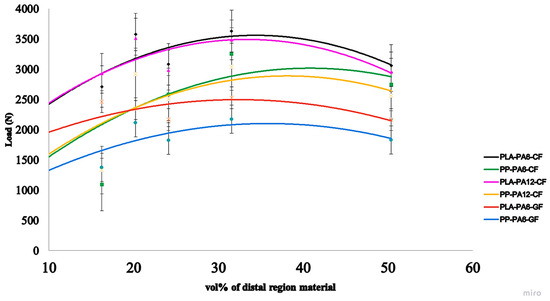
Figure 8.
Load-bearing capacity variation with vol% composition for various distal (minor) region materials.
A maximum load-bearing capacity of 3650 N was achieved with the combination of PLA+ and 31.54 vol% PA6-CF (30.23 weight%, 99.13 g), costing about USD 14 for the total socket material. Similarly, the combination of PLA+ with 31.54 vol% PA6-GF (30.76 weight%, 101.67 g) costing about USD 13 for the material, exhibited a maximum load-bearing capacity of 2528.91 N.
Minor compositions of PA6-GF, PA6-CF, and PA12-CF filaments within PP and PLA+, weighing between 89 g and 99 g, equivalent to 28 weight% to 37 weight%, could enhance the overall load-bearing capacities of these socket materials between 2173 N and 3630 N, which is significantly higher than the single-material PP- and PLA+-based sockets.
4. Discussion
This research proposes a two-material hybrid transtibial socket for enhancing the load-bearing capacity, which provides a significant design improvement to enable lower-limb prosthesis users to adopt a socket solution that could assist them to pursue more types of certain strenuous activities without spending additional costs. Single conventional material-based socket designs using PP and PLA+ resulted in useful load-bearing capacities of up to 1320 N, which favors their application for prosthesis users who wish to lead a sedentary lifestyle and follow primarily standing- and walking-related activities.
For prosthesis users who aspire to lead a healthier lifestyle and follow brisk walking and running activities, they need to afford sockets fabricated by using CF- and GF-based polymer materials such as PA6-CF, PA6-GF, and PA12-CF. However, full adult-size sockets based out of these materials would weigh nearly 320 g and cost nearly USD 40 to USD 55 (material only), which becomes an unaffordable option for a prosthesis user.
In this paper, we explored the possibilities of designing such socket components using FEA by involving two materials, out of which the major material would be the cost-effective polymer that is easily available and easy to handle, while the other in minor quantity would be the high-strength and expensive component that would act as the critical load-bearing component to support the strenuous physical activity without compromising on safety and failure. Three-dimensional printing provides an excellent opportunity for fabricating such hybrid material-based sockets that would provide the desired accuracy, customization, and load-bearing capacity, enabling prosthesis users to lead their desired lifestyle without inhibitions.
Tensile strengths and Young’s moduli for PA6-GF filaments are 50.8 MPa and 2053 MPa, for PA6-CF filaments are 81.7 MPa and 5666 MPa, and for PA12-CF filaments are 73.4 MPa and 3054 MPa, respectively. Due to these higher mechanical properties, primarily due to the CF and GF component, their presence within a polymer-based socket material could enhance the overall load-bearing capacity of the socket. Single-material filaments of PP- and PLA+-based socket components that weighed 300 g and 330 g, respectively, were subjected to heavy external loading to evaluate their load-bearing capacities, and it was observed that they could bear a maximum load of 700 N and 1320 N, respectively, which poses extreme vulnerability for any real-life load-bearing activity. Therefore, combining them with filaments of CF- and GF-based polymer materials could enhance their mechanical strength without adding substantial weight. Minor compositions of PA6-GF, PA6-CF, and PA12-CF filaments of nearly 89 g to 99 g equivalent to 28 weight% to 37 weight% could enhance the overall load-bearing capacities of these PP and PLA+ socket materials between 160% to 275%.
Socket materials are desired to be light in weight and higher in mechanical strength to be able to sustain heavy external loading without failures. The presence of minor compositions of CF- and GF-based fibers at critical locations within the socket is a design innovation that would enhance the usability and application of a transtibial socket for a wide range of activities that a prosthesis user aspires to follow. With the use of suitable liner materials, the proximal region having a major composition of PLA+-based polymer materials would ensure a patient remains comfortable at the skin-contact section. Moreso, these materials remain stable within the usual environmental conditions, thereby suggesting long-term durability. Since CF- and GF-based materials located at the distal regions would sustain the majority of the external loading conditions, the socket material failure rates would also diminish. This would keep the overall weight minimal and hence enhance the overall life of the socket. To design such two-material sockets, a convenient procedure has been proposed, wherein the composition of the minor mechanically stronger material needs to be added at the distal end of the socket, and the composition can be added further in incremental steps of 5 cm height towards the proximal end.
Load-bearing capacities as 3630.49 N, 3249.70 N, 3485.28 N, 3040.40 N, 2528.91 N, and 2173.15 N for PLA+ with PA6-CF (30.23 weight%, 99.13 g), PP with PA6-CF (37.09 weight%, 99 g), PLA+ with PA12-CF (28.18 weight% 89.81 g), PP with PA12-CF 34.82 weight%, 89.81 g), PLA+ with PA6-GF (30.76 weight%, 101.67 g), and PP 37.68 weight%, 101.67 g) were obtained, respectively.
Single-material CF- and GF-based polymer material sockets, despite their high mechanical strength, would remain unaffordable due to their high cost of nearly USD 40 to USD 55 per piece of socket. However, based on the findings of this study, we suggest incorporating only 30 weight% or 100 g of CF- or GF-based polymer materials to generate a heavy load-bearing socket design, for a cost of nearly USD 13 to USD 27 per socket, thereby proposing a cost-effective socket solution. The incorporation of CF into PA6 and PA12 matrices resulted in significant enhancements to their mechanical attributes, as demonstrated by the elevated tensile yield strength and diminished deformation. Functioning as a reinforcing agent, carbon facilitates a more uniform distribution of stress, thereby augmenting the material’s load-bearing capacity. The introduction of carbon or glass fibers substantially alters the composition and characteristics of a polymer matrix. Composed of carbon atoms arranged in a crystalline structure, carbon fibers confer notable improvements in tensile strength, stiffness, and thermal resistance to the composite material. When integrated into polymers such as PA12 or PA6, carbon fibers establish robust covalent bonds with the polymer matrix, leading to enhanced mechanical properties, including favorable strength-to-weight ratios and durability under cyclic loading conditions [42]. Nonetheless, the reliance on high-performance fibers necessitates advanced manufacturing processes and expert handling, which could be challenging for large-scale production. Future research should focus on optimizing fiber content and distribution, exploring alternative low-cost reinforcing agents, and validating long-term performance under clinical conditions to further enhance the design’s economic viability and mechanical reliability.
Increasing the proportion of high-strength material beyond this percentage results in saturation and marginal decline in the load-bearing capacity of the sockets. It is hereby suggested that due to increased rigidity, the material resists deformation and leads to the induction of higher stress values of reinforced material, indicating that further increases may not be useful [34,35]. Based on the load-bearing capacities of each material and their combinations, a summary of the material with a specific preferred activity has been suggested in Table 3 as below. The table represents the different loading scenarios experienced by the human body during different activities.

Table 3.
Suggested activities for prosthesis users as per socket material.
While FDM-based 3D printing presents inherent limitations in inter-layer adhesion, which can reduce overall material strength, technological advancements are continually improving the reliability of multi-material prints. The effective strength of hybrid two-material combinations at the interface is a critical factor in ensuring structural integrity. To enhance adhesion and mechanical performance, post-processing techniques such as plastic welding can be employed. Studies on plastic joining methods—including ultrasonic welding, hot-gas welding, and hot-plate welding—demonstrate their effectiveness in reinforcing interfacial bonds in 3D-printed components [36,43,44,45]. The further optimization of these post-processing techniques, along with advancements in multi-material printing parameters, is essential for improving scalability and ensuring consistent quality in hybrid socket production [46,47].
Traditional polymer material-based sockets, manufactured using plaster molds and milling, are affordable and easy to produce. However, their conventional fabrication process is time consuming and environment (moisture) dependent; due to this, a patient has to undergo longer wait times. Also, repeated measurements and iterations due to manual interventions remain drawbacks of these methods. However, the AM-based methods provide an excellent alternative for ease in designing and manufacturing and shorter patient wait times with minimal iterations. As these AM-based methods are yet to be validated for long-term scalable use, their durability remains a concern. Capital expenditure for setting up scanning, designing, and 3D printing machines also remains a challenge, along with the availability and affordability of highly skilled human resources for the running and maintenance of this scientific equipment. Overall, in due course of time, as technologies advance, these AM-based processes would become stabilized and provide a superior alternative to the conventional socket manufacturing solutions in terms of accuracy, reliability, and affordability.
The novel design innovation suggested in this study for achieving these interesting results is also convenient to adopt and apply across any FEM/FEA modeling. By following the simplest design procedures, these combined material sockets were designed for FEA by adding the high-strength material from the distal base end, moving upwards towards the proximal end of the socket. Majorly, at a height of nearly 10 cm from the distal end, 35% of total height, a maximum load-bearing capacity between 2173 N and 3650 N could be obtained by composing only 31 vol% of PA6-CF, PA12-CF, and PA6-GF materials in PLA+- or PP-based sockets. In this way, every increment would increase the composition weight of the minor material, and an optimal value would be expected at nearly 30 weight% or 100 g in this study.
5. Conclusions
A lower-limb amputation inhibits a patient’s life adversely, which can also isolate them from society. Lower-limb sockets have been revolutionizing the lives of such prosthesis users significantly over the past several years, and with the advent of digital technologies, novel innovations are making significant disruptions in this area.
This study highlights the versatility of hybrid material configurations in addressing diverse user requirements. By leveraging the benefits of AM, this approach offers scalable, customizable, and cost-effective solutions for prosthetic socket design. These materials demonstrated exceptional tensile strength and resistance to deformation, ensuring the structural integrity of transtibial sockets under high-stress conditions. The judicious selection of materials profoundly influences the functional efficacy, comfort, and safety of prosthetic sockets, underscoring the necessity for meticulous consideration during the design process. Conversely, materials such as PLA+ exhibited limitations in their mechanical properties, potentially compromising the performance of prosthetic sockets under extreme loading conditions. This variation in performance across different materials emphasizes the crucial role of informed material selection in enhancing the design and functionality of the sockets.
Utilizing advanced simulation techniques through FEA, we conducted a comprehensive analysis of the load-bearing capacities of transtibial sockets made up of various polymers and two hybrid materials. Findings indicate that combining CF- and GF-based polymer materials, such as PA6-CF, PA6-GF, and PA12-CF, with PP and PLA+ exhibited superior mechanical characteristics that led to enhanced load-bearing capacities between 160% and 250%, within a material cost between USD 13 and USD 27 per socket, and an overall weight composition between 28% and 37%, making them highly suitable for applications that demand elevated strength and minimal distortion. The suggested explanation for this significant enhancement has been the presence of critical stress concentration points within the CF region and the high strength and rigidity of CF. The presence of these materials within the distal region of a transtibial socket, would relieve the stress concentration sites and prevent failure of the socket. This region needs to support the fitment of the adapter and pylon through holes and attachments, which are performed through various assembly manufacturing procedures, thereby compromising the overall socket material strength within this region. Therefore, the presence of high-strength CF and GF materials through an optimal design enables reduced stress distribution across the socket material, hence enhancing the durability of the socket and the safety of a prosthesis user.
The successful and scalable manufacturing of two-material combination sockets would require high-quality industrial 3D printers capable of precise multi-material printing at faster speeds that would be expensive to setup and maintain. A two-material combination would require a critical transition level within the socket with precision to avoid overlapping. Additionally, skilled manpower is essential to optimize print settings, ensure material compatibility, and conduct necessary post-processing for enhanced durability. Facility setup and infrastructure investments also play a crucial role, as controlled environments are needed to maintain consistent print quality. A digital manufacturing setup focused on 3D scanning, designing, and printing technologies has the potential to revolutionize the prosthetic and orthotics industry. Considering the setup of such a facility as a one-time investment for developing lower-limb sockets, other devices such as splints, exoskeletons, braces, etc., could also be supported. This would also help in creating digital repository models and case studies for future referencing by other scientific communities. Remote assistance and advisory in complex cases would also be feasible by setting up such a facility.
In conclusion, this investigation makes a significant contribution to the ongoing efforts to improve transtibial prosthetic sockets for advancing the quality of life for individuals who rely on these technologies. This opens up a new potential to explore alternate material combinations to improve the strength of transtibial sockets. Prosthesis users who aspire to lead an active life with a focus on their overall health need to follow a certain lifestyle. Regular routines of walking, running, jogging, and other strenuous activities would benefit them significantly with the hybrid two-material socket designs, primarily due to their cost-effectiveness and high load-bearing capacity. To scale up the production and affordability of these sockets, alternate high-strength nano-scale materials requiring even smaller compositions within these sockets could be explored. To propose a comprehensive transtibial socket solution, a focus on the long term under cyclic loading with gait analysis coupled with static loading and trauma studies need to be conducted in combinations. The validation of these results would also require trials on the response from prosthesis users, which could be planned for future studies. Such studies would instill confidence amongst prosthesis users to adopt AM-based transtibial socket solutions, as the users would have flexibility in application for switching over to multiple activities without any inhibition.
Author Contributions
Conceptualization, C.T.B. and P.J.; Data Curation, P.P. and H.B.; Formal Analysis, P.S. and M.A.M.D.; Funding Acquisition, P.J., C.T.B., and P.B.; Investigation, P.P. and P.S.; Methodology, P.P. and H.B.; Project Administration, P.J., C.T.B., and P.B.; Resources, P.J., C.T.B., and P.B.; Software, P.S. and M.A.M.D.; Supervision, P.J., C.T.B., and P.B.; Validation, P.P. and H.B.; Visualization, P.P. and P.S.; Writing—Original Draft, P.P.; Writing—Review and Editing, P.J., C.T.B., and P.B. All authors have read and agreed to the published version of the manuscript.
Funding
The authors are grateful to the Nottingham Trent University UK International Partnership Fund (IPF) scheme for funding this work and to the Nottingham Trent University-Panjab University Strategic Partnership Program for funding the ANSYS 15 2022 R2 software.
Institutional Review Board Statement
Not applicable.
Informed Consent Statement
Not applicable.
Data Availability Statement
Data could be shared to the reader as per request.
Acknowledgments
The authors thank the Ministry of Education (MoE), Government of India, for funding this project (17-11/2015-PN-1) under the sub-theme Medical Devices and Restorative Technologies at the Design Innovation Centre (DIC). The authors duly acknowledge the recommendations by Priyam Pal, Clinical Prosthetist and Orthotist (CPO) for the residual limb markings and socket design.
Conflicts of Interest
The authors declare no conflicts of interest.
Abbreviations
The following abbreviations are used in this manuscript:
| AM | Additive Manufacturing |
| PP | Polypropylene |
| PLA+ | Polylactic-acid-plus |
| PA | Polyamide |
| PA6-GF | Polyamide-6-Glass-Fiber |
| CoPA | Polyamide-copolymer |
| PA6-CF | Polyamide-6-Carbon-Fiber |
| PA12-CF | Polyamide-12-Carbon-Fiber |
| FEA | Finite Element Analysis |
| FDM | Fused Deposition Modeling |
| CAD | Computer-Aided Design |
| FEM | Finite Element Method |
References
- Krishnan, A.A.; Ghyar, R.; Ravi, B. Comparison of four modular TKA prosthesis designs using static finite element analysis. J. Comput. Methods Sci. Eng. 2017, 17, 315–320. [Google Scholar] [CrossRef]
- Ezzatvar, Y.; García-Hermoso, A. Global estimates of diabetes-related amputations incidence in 2010–2020: A systematic review and meta-analysis. Diabetes Res. Clin. Pract. 2023, 195, 110194. [Google Scholar] [CrossRef]
- Moxey, P.W.; Gogalniceanu, P.; Hinchliffe, R.J.; Loftus, I.M.; Jones, K.J.; Thompson, M.M.; Holt, P.J. Lower extremity amputations—A review of global variability in incidence. Diabet. Med. 2011, 28, 1144–1153. [Google Scholar] [CrossRef] [PubMed]
- Ramlee, M.H.; Ammarullah, M.I.; Sukri, N.S.M.; Hassan, N.S.F.; Baharuddin, M.H.; Kadir, M.R.A. Investigation on three-dimensional printed prosthetics leg sockets coated with different reinforcement materials: Analysis on mechanical strength and microstructural. Sci. Rep. 2024, 14, 6842. [Google Scholar] [CrossRef]
- Al-Khazraji, K.; Kadhim, J.; Ahmed, P.S. Tensile and Fatigue Characteristics of Lower-Limb Prosthetic Socket Made from Composite Materials. In Proceedings of the 2012 International Conference on Industrial Engineering and Operations Management, Istanbul, Turkey, 3–6 July 2012. [Google Scholar]
- Manz, S.; Valette, R.; Damonte, F.; Gaudio, L.A.; Gonzalez-Vargas, J.; Sartori, M.; Dosen, S.; Rietman, J. A review of user needs to drive the development of lower limb prostheses. J. Neuroeng. Rehabil. 2022, 19, 119. [Google Scholar] [CrossRef]
- Waller-Cotterhill, C. Experimental Reconstruction of a Nineteenth Century Lower Limb Prosthetic Peg Leg—The Box Leg. EXARC J. 2018. Available online: https://exarc.net/ark:/88735/10365 (accessed on 10 March 2025).
- Gariboldi, F.; Scapinello, M.; Petrone, N.; Migliore, G.L.; Teti, G.; Cutti, A.G. Static strength of lower-limb prosthetic sockets: An exploratory study on the influence of stratigraphy, distal adapter and lamination resin. Med. Eng. Phys. 2023, 114, 103970. [Google Scholar] [CrossRef]
- Rai, P.; Jankiraman, V.; Teacher, M.; Velu, R.; Kumar, S.A.; Binedell, T.; Subburaj, K. Design and optimization of a 3D printed prosthetic socket for transtibial amputees. Mater. Today Proc. 2022, 70, 454–464. [Google Scholar] [CrossRef]
- Prosthetic Management: Overview, Methods, and Materials|O&P Virtual Library. Available online: http://www.oandplibrary.org/alp/chap04-01.asp (accessed on 12 February 2025).
- Pirouzi, G.; Abu Osman, N.A.; Eshraghi, A.; Ali, S.; Gholizadeh, H.; Abas, W.W. Review of the socket design and interface pressure measurement for transtibial prosthesis. Sci. World J. 2014, 2014, 849073. [Google Scholar] [CrossRef]
- Baldock, M.; Pickard, N.; Prince, M.; Kirkwood, S.; Chadwell, A.; Howard, D.; Dickinson, A.; Kenney, L.; Gill, N.; Curtin, S. Adjustable prosthetic sockets: A systematic review of industrial and research design characteristics and their justifications. J. Neuroeng. Rehabil. 2023, 20, 147. [Google Scholar] [CrossRef]
- Aimar, A.; Palermo, A.; Innocenti, B. The Role of 3D Printing in Medical Applications: A State of the Art. J. Healthc. Eng. 2019, 2019, 5340616. [Google Scholar] [CrossRef]
- Jweeg, M.; Radhi, S.; Al-Shuka, H. An Experimental comparative study between polypropylene and laminated lower limb prosthetic socket. Al-Khwarizmi Eng. J. 2007, 3, 40–47. [Google Scholar]
- Jindal, P.; Prakash, P.; Bassal, H.; Kumar, K.; Singh, P.; Din, M.A.M.; Barnett, C. Mechanical characterization of Lower Limb 3D printed socket materials under static external loading. Trans. Addit. Manuf. Meets Med. 2024, 6, 1885. [Google Scholar] [CrossRef]
- Marinopoulos, T.; Li, S.; Silberschmidt, V.V. AM lower-limb prosthetic socket: Using FEA for improved mechanical performance. Mater. Today Proc. 2022, 70, 499–503. [Google Scholar] [CrossRef]
- Myers, J.; Phillips, D. Characterization of 3D Printed Lattice Structures Used in the Design of Modified Compression Release Stabilized Transhumeral Prosthetic Sockets. Ph.D. Thesis, Kate Gleason College of Engineering, Rochester, NY, USA, 2023. [Google Scholar]
- Chiad, J.S.; Tahir, M.S.A.-D. A Suggested New Material to Manufacture Above-Knee Prosthetic Socket Using the Lamination of Monofilament, Cotton and Perlon Fibers. Al-Nahrain J. Eng. Sci. 2017, 20, 832–837. [Google Scholar]
- Irawan, A.P. Mechanical Characteristics Rattan Fiber Reinforced Epoxy Composites (RECO) as Above Knee Socket Prosthesis Materials. 2011. Available online: https://www.researchgate.net/publication/299409869 (accessed on 12 December 2024).
- Mechi, S.A.; Al-Waily, M. International Journal of Energy and Environment Manufacturing and Mechanical Behavior Investigation of Prosthetic Below Knee Socket by Using Natural Kenaf Fiber. 2021. Available online: www.IJEE.IEEFoundation.org (accessed on 12 December 2024).
- Wilson, A.B. Standards for lower limb prostheses. Prosthet. Orthot. Int. 1979, 3, 44–45. [Google Scholar] [CrossRef][Green Version]
- Peyer, K.E.; Brassey, C.A.; Rose, K.A.; Sellers, W.I. Locomotion pattern and foot pressure adjustments during gentle turns in healthy subjects. J. Biomech. 2017, 60, 65–71. [Google Scholar] [CrossRef]
- Kunishima, T.; Nagai, Y.; Nagai, S.; Kurokawa, T.; Bouvard, G.; Abry, J.-C.; Fridrici, V.; Kapsa, P. Effects of glass fiber properties and polymer molecular mass on the mechanical and tribological properties of a polyamide-66-based composite in contact with carbon steel under grease lubrication. Wear 2020, 462–463, 203500. [Google Scholar] [CrossRef]
- Sunderland, F.E.; Bramley, J.L.; Al-Dirini, R.M.A.; Steer, J.W.; Worsley, P.R.; Dickinson, A.S. OpenLimb: An Open Source Transtibial Residual Limb Model for Simulation and Design. In Proceedings of the International Society for Prosthetics & Orthotics (ISPO) World Congress 2023: The Art and the Science, Guadalajara, Mexico, 24–27 April 2023; International Society for Prosthetics and Orthotics: Copenhagen, Denmark, 2023; Volume 47. Available online: http://eprints.soton.ac.uk/id/eprint/474951 (accessed on 10 March 2025).
- Lenka, P.K.; Choudhury, A.R. Analysis of trans tibial prosthetic socket materials using finite element method. J. Biomed. Sci. Eng. 2011, 4, 762–768. [Google Scholar] [CrossRef]
- Rwei, S.-P.; Tseng, Y.-C.; Chiu, K.-C.; Chang, S.-M.; Chen, Y.-M. The crystallization kinetics of Nylon 6/6T and Nylon 66/6T copolymers. Thermochim. Acta 2013, 555, 37–45. [Google Scholar] [CrossRef]
- Polypropylene—An Overview|ScienceDirect Topics. Available online: https://www.sciencedirect.com/topics/materials-science/polypropylene (accessed on 15 December 2024).
- Sin, L.T.; Tueen, B.S. Eco-profile of plastics. In Plastics and Sustainability; Elsevier: Amsterdam, The Netherlands, 2023; pp. 45–89. [Google Scholar] [CrossRef]
- BASF, BASF PP. Available online: https://move.forward-am.com/hubfs/AES%20Documentation/Standard%20Filaments/PP/TDS/Ultrafuse_PP_TDS_EN_v4.0.pdf (accessed on 22 December 2024).
- Polymaker, PolyTerraTM PLA+ Filament. Available online: https://polymaker.com/wp-content/uploads/lana-downloads/PolyTerra-PLA-EN_V5.3.pdf (accessed on 22 December 2024).
- BASF, BASF PA Natural. Available online: https://move.forward-am.com/hubfs/AES%20Documentation/Engineering%20Filaments/PA/TDS/Ultrafuse_PA_TDS_EN_v2.2.pdf (accessed on 22 December 2024).
- Polymaker, PolyMide_PA6_GF_TDS_V5.1. Available online: https://polymaker.com/wp-content/uploads/lana-downloads/PolyMide_PA6_GF_TDS_V5.1.pdf (accessed on 22 December 2024).
- Polymaker, PolyMide_CoPA_TDS_V5.2. Available online: https://polymaker.com/wp-content/uploads/lana-downloads/PolyMide_CoPA_TDS_V5.2.pdf (accessed on 22 December 2024).
- Polymaker, PolyMide_PA6_CF_TDS_V5.2. Available online: https://polymaker.com/wp-content/uploads/lana-downloads/PolyMide_PA6_CF_TDS_V5.2.pdf (accessed on 22 December 2024).
- Polymaker, PolyMide_PA12_CF_TDS_V5.1.1. Available online: https://polymaker.com/wp-content/uploads/lana-downloads/PolyMide_PA12_CF_TDS_V5.1.1.pdf (accessed on 22 December 2024).
- Haque, M.S.; Siddiqui, M.A. Plastic Welding: Important Facts and Developments. Am. J. Mech. Ind. Eng. 2016, 1, 15–19. [Google Scholar] [CrossRef]
- Patil, H.; Jeyakarthikeyan, P.V. Mesh convergence study and estimation of discretization error of hub in clutch disc with integration of ANSYS. IOP Conf. Ser. Mater. Sci. Eng. 2018, 402, 012065. [Google Scholar] [CrossRef]
- Zhou, H. Direct Solver for Large Sparse Linear Systems of Equations. Available online: https://www.wias-berlin.de/people/john/BETREUUNG/bachelor_zhou.pdf (accessed on 11 February 2025).
- Choosing a Solver for FEM: Direct or Iterative?|SimScale. Available online: https://www.simscale.com/blog/how-to-choose-solvers-for-fem/ (accessed on 11 February 2025).
- Gould, N.I.M.; Scott, J.A.; Hu, Y. A Numerical Evaluation of Sparse Direct Solvers for the Solution of Large Sparse Symmetric Linear Systems of Equations. ACM Trans. Math. Softw. 2007, 33, 10-es. [Google Scholar] [CrossRef]
- ANSYS, Introduction to Contact. Available online: https://innovationspace.ansys.com/courses/wp-content/uploads/sites/5/2019/05/2.5.1-Introduction-on-contact_New_Template_Master.pdf (accessed on 12 February 2025).
- Elanchezhian, C.; Ramnath, B.V.; Hemalatha, J. Mechanical Behaviour of Glass and Carbon Fibre Reinforced Composites at Varying Strain Rates and Temperatures. Procedia Mater. Sci. 2014, 6, 1405–1418. [Google Scholar] [CrossRef]
- Gregor-Svetec, D. Polymers in printing filaments. In Polymers for 3D Printing: Methods, Properties, and Characteristics; William Andrew Publishing: Norwich, NY, USA, 2022; pp. 155–269. [Google Scholar] [CrossRef]
- Jia, X.; Hao, K.; Luo, Z.; Fan, Z. Plastic Deformation Behavior of Metal Materials: A Review of Constitutive Models. Metals 2022, 12, 2077. [Google Scholar] [CrossRef]
- Palaniyappan, S.; Sivakumar, N.K.; Bodaghi, M.; Kumar, M.; Rahaman, M. A feasibility study of various joining techniques for three-dimensional printed polylactic acid and wood-reinforced polylactic acid biocomposite. Proc. Inst. Mech. Eng. Part L J. Mater. Des. Appl. 2023, 238, 475–480. [Google Scholar] [CrossRef]
- Li, X.; Qu, P.; Kong, H.; Lei, Y.; Guo, A.; Wang, S.; Wan, Y.; Takahashi, J. Enhanced mechanical properties of sandwich panels via integrated 3D printing of continuous fiber face sheet and TPMS core. Thin-Walled Struct. 2024, 204, 112312. [Google Scholar] [CrossRef]
- Li, X.; Qu, P.; Kong, H.; Zhu, Y.; Hua, C.; Guo, A.; Wang, S. Multi-scale numerical analysis of damage modes in 3D stitched composites. Int. J. Mech. Sci. 2024, 266, 108983. [Google Scholar] [CrossRef]
Disclaimer/Publisher’s Note: The statements, opinions and data contained in all publications are solely those of the individual author(s) and contributor(s) and not of MDPI and/or the editor(s). MDPI and/or the editor(s) disclaim responsibility for any injury to people or property resulting from any ideas, methods, instructions or products referred to in the content. |
© 2025 by the authors. Licensee MDPI, Basel, Switzerland. This article is an open access article distributed under the terms and conditions of the Creative Commons Attribution (CC BY) license (https://creativecommons.org/licenses/by/4.0/).